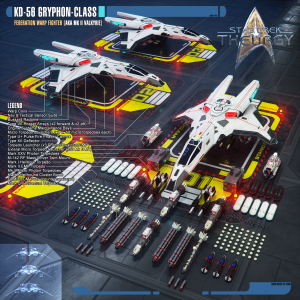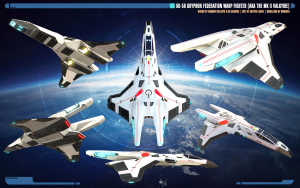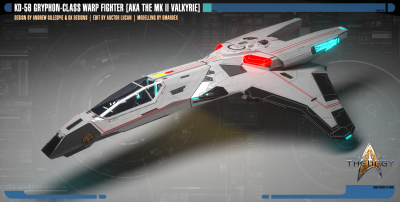AC-307 Mk II Valkyrie: Difference between revisions
From Star Trek: Theurgy Wiki
Auctor Lucan (talk | contribs) |
Auctor Lucan (talk | contribs) |
||
| Line 113: | Line 113: | ||
== Production History == | == Production History == | ||
The formation of the Starfleet Aerospace Command is heavily influenced by the successful deployment of Peregrine-class fighters aboard the starships serving as carriers in the fleet, yet the ''[[U.S.S._Theurgy_NX-79854|USS Theurgy]]'' does not hold a squadron of Peregrine-class fighter aboard, but the more developed Valkyrie-class. Namely, the [[AC-409 Mk III Valkyrie|prototype Mk III version]], a superior fighter that make use of recent advances in technology. | The formation of the Starfleet Aerospace Command is heavily influenced by the successful deployment of Peregrine-class fighters aboard the starships serving as carriers in the fleet, yet the ''[[U.S.S._Theurgy_NX-79854|USS Theurgy]]'' does not hold a squadron of Peregrine-class fighter aboard, but the more developed Valkyrie-class. Namely, the [[AC-409 Mk III Valkyrie|prototype Mk III version]], a superior fighter that make use of recent advances in technology. | ||
| Line 119: | Line 118: | ||
Another development at the time was that a group of influential admirals in the fleet demanded to form a new department that hand-picked the [[Command, Tactical & CONN|Conn]] officers with the most tactical training. It was the only way, they reckoned, to ensure that the fleet used the right kind of pilots for these fighters. The original score of 400 personnel - the fleets new Tactical CONN officers - served as the foundation for a new and more organised department for fighter pilots. They accepted only the highest scoring Conn or fight-trained [[Security]] or [[Command, Tactical & CONN|Tactical]] Cadets, and then dealt them another year of training in the fields they lacked from their [[Starfleet Academy|Academy]] training. White became the chosen colour for the department, and the admirals that rode this project into history became the core of the Aerospace Command. | Another development at the time was that a group of influential admirals in the fleet demanded to form a new department that hand-picked the [[Command, Tactical & CONN|Conn]] officers with the most tactical training. It was the only way, they reckoned, to ensure that the fleet used the right kind of pilots for these fighters. The original score of 400 personnel - the fleets new Tactical CONN officers - served as the foundation for a new and more organised department for fighter pilots. They accepted only the highest scoring Conn or fight-trained [[Security]] or [[Command, Tactical & CONN|Tactical]] Cadets, and then dealt them another year of training in the fields they lacked from their [[Starfleet Academy|Academy]] training. White became the chosen colour for the department, and the admirals that rode this project into history became the core of the Aerospace Command. | ||
[[File:CLOSE-UP-GRYPHON-WARP-FIGHTER.png|400px|left]] | |||
Both the Mk I and [[AC-307 Mk II Valkyrie|II]] Valkyries used Rear Intercept Officers (RIOs). The efficiency in which the attack fighters were operated were doubled by allowing the pilots to focus solely on the manoeuvres and weapons employment of the craft during a fight, allowing the RIO to handle comm traffic, emergency repairs and tactic simulations. Among the improvements for the [[AC-307 Mk II Valkyrie|Mk II Valkyrie]] were a new ablative armour compound, improved power plant, and the employment of a hardpoint system beneath the wings. With the Mk II, the Valkyrie truly stepped into a class of her own. At the success of the Mk II and the fleet-wide deployment of the Valkyries in the fleet, Starfleet Command began looking into the Valkyrie with more interest | Both the Mk I and [[AC-307 Mk II Valkyrie|II]] Valkyries used Rear Intercept Officers (RIOs). The efficiency in which the attack fighters were operated were doubled by allowing the pilots to focus solely on the manoeuvres and weapons employment of the craft during a fight, allowing the RIO to handle comm traffic, emergency repairs and tactic simulations. Among the improvements for the [[AC-307 Mk II Valkyrie|Mk II Valkyrie]] were a new ablative armour compound, improved power plant, and the employment of a hardpoint system beneath the wings. With the Mk II, the Valkyrie truly stepped into a class of her own. At the success of the Mk II and the fleet-wide deployment of the Valkyries in the fleet, Starfleet Command began looking into the Valkyrie with more interest. | ||
== External Hard-point Options == | == External Hard-point Options == | ||
Revision as of 13:41, 5 July 2016
[UNDER CONSTRUCTION]
These are the warp fighters that were commissioned to the USS Resolve and the USS Harbinger, among other ships in Starfleet during the end of the 24th century.
Fighter Demonstration
Production History
The formation of the Starfleet Aerospace Command is heavily influenced by the successful deployment of Peregrine-class fighters aboard the starships serving as carriers in the fleet, yet the USS Theurgy does not hold a squadron of Peregrine-class fighter aboard, but the more developed Valkyrie-class. Namely, the prototype Mk III version, a superior fighter that make use of recent advances in technology.
The year 2375 - after the conclusion of the Dominion War - the AC-409 Mk I Valkyries were deployed. These fighters were assigned to the USS Typhon (TNG game: Star Trek: Invasion). They were initially designed as a carrier-based fleet engagement craft. Initially, the design proved successful, with a high survivability rate matching the heavy fire power available to bring down larger ships. In learning that a full squadron of Valkyries would still require a lot of support from for engagements of a Dominion-War level threat, Starfleet deemed that the attack fighter needed an upgrade. By 2381, these fighters are still being deployed in fairly limited numbers - shuffled around the fleet.
Another development at the time was that a group of influential admirals in the fleet demanded to form a new department that hand-picked the Conn officers with the most tactical training. It was the only way, they reckoned, to ensure that the fleet used the right kind of pilots for these fighters. The original score of 400 personnel - the fleets new Tactical CONN officers - served as the foundation for a new and more organised department for fighter pilots. They accepted only the highest scoring Conn or fight-trained Security or Tactical Cadets, and then dealt them another year of training in the fields they lacked from their Academy training. White became the chosen colour for the department, and the admirals that rode this project into history became the core of the Aerospace Command.
Both the Mk I and II Valkyries used Rear Intercept Officers (RIOs). The efficiency in which the attack fighters were operated were doubled by allowing the pilots to focus solely on the manoeuvres and weapons employment of the craft during a fight, allowing the RIO to handle comm traffic, emergency repairs and tactic simulations. Among the improvements for the Mk II Valkyrie were a new ablative armour compound, improved power plant, and the employment of a hardpoint system beneath the wings. With the Mk II, the Valkyrie truly stepped into a class of her own. At the success of the Mk II and the fleet-wide deployment of the Valkyries in the fleet, Starfleet Command began looking into the Valkyrie with more interest.
External Hard-point Options
The Mk III Valkyrie can hold up to 4 external hard points wingmounted during missions, listed below.
ECM Pod/ECCM Emitter
Counter measures. ECM [Electric Counter Measure] is essentially is a micro torpedo full of shrapnel and debris with the given craft's transponder signature and sensor reading. It confuses the enemy ordinance and causes it to think the cloud of debris is the target. ECCM [Electric Chemical Counter Measure] creates a wake similar to a warp, impulse or thruster engine's wake, fooling such a guided missile into a false lock.
Additional Torpedo Launcher
Additional, wing-mounted torpedo launcher that can hold either 5 Mk XXVII photon torpedoes or 15 micro torpedoes. Recommended to mount two of these in order to balance the fighter properly.
Mk XXVII Photon Torpedo
Standard photon torpedo ordinance. Explosion is a matter-antimatter reaction producing large amounts of gamma waves as its primary means of destruction.
Mk Q-IV Quantum Torpedo
An improvement of the Mk XXVII photon torpedo with higher yield. A tactical quantum weapon, that utilize a plasma warhead and used casings similar in shape to photon torpedoes. The explosion leaves an antimatter residue and although they were powerful weapons, even a direct hit from a quantum torpedo might not destroy neutronium alloyed targets.
Mk I Hellborne Torpedo
Photon torpedo type weapon that results in a nuclear fission reaction, named for its use of standard nuclear radioactive bomb materials [Uranium, Plutonium etc.] The nuclear bomb detonates and this compresses hydrogen into helium creating a fusion reaction. Within the hydrogen core is a core of neutronium which the fusion reaction detonates. This detonation is equivalent 3 photon torpedo that detonate only a few moments after it contacts its target rather than detonating near the target, this because of the penetrate-and detonate-package in its casing. This weapon is highly ineffective against targets with fully powered shields. Against heavily armoured targets without any shielding left, this may be the only viable option that will punch through the heavy armour. The pilot can disable the penetrative package from the fighter to make one behave like a standard Tri-Nuclear Torpedo.
EMP Torpedo
Creates the electromagnetic pulse similar to what is created from the high atmosphere detonation of a nuclear warhead. A well shielded craft will withstand this easily but the weapon detonates in a burst of broadband, high-intensity electromagnetic energy, capable of disrupting magnetic fields and producing current or voltage surges in conductive materials via magnetic induction.
Hell Hound Cluster Bomb
Similar to the nature of a photon torpedo. Essentially, this is a photon torpedo stuffed with several micro torpedoes. The casing is opened upon a certain point releasing the small torps resulting in a large pattern of torpedo detonations.
Ejection Systems
Escape Pod
All Valkyries are equipped with ejection modules or "pods". These allow for rapid emergency egress from the vehicle in case of danger. Linked to dedicated high speed processors, automatic sensors can detect certain types of danger and initiate an eject sequence automatically. This is especially useful if the pilot has been rendered unconscious through a blackout or other injury and the vehicle is in danger of crashing.
Modules have self-righting mechanisms in their base to assure a correct orientation during landing. Landing is accomplished by a single use anti-grav module. Free falling until they are 3 meters from the ground, the ejection seat/pod activates the AG module, which burns out as it lands the unit (relatively) gently. The pod remains pressurized with approximately 20 minutes of air, allowing a pilot time to completely seal his suit and activate his personal survival equipment. Once ready, the pilot has the option of discarding the pod by activating a manual release.
ETS (Emergency Transport System)
By the late 24th century, emergency transport was further improved through Starfleet's development of a single-person, single-use, one-way emergency transport unit. The device was small enough to be hand-held and could transport to specified coordinates with a single touch. Because of its extreme limitations, this device was not widely deployed and was still considered a prototype in 2379. [see Star Trek: Nemesis]
The Valkyries have built-in Emergency Transport Systems [ETS] in the cockpit - not the small prototype version - designated to the pilot and worn gear alone, with a one-way pre-set location for the USS Theurgy. The Emergency transporter can be reprogrammed to send the pilot to a new - by the pilot chosen - location because of the possibility of long-range missions, but this system is best utilised in the event of defending the Theurgy - being within Transporter range.



